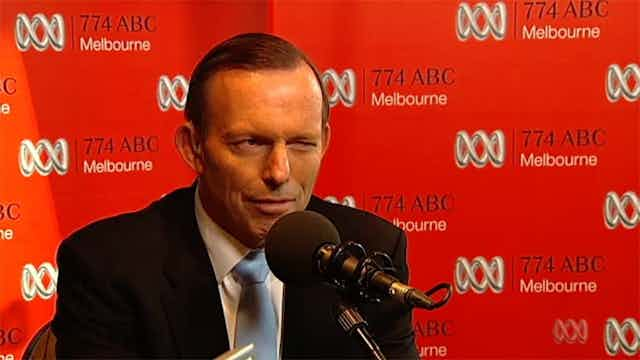During a radio show yesterday, Prime Minister Tony Abbott winked.
In and of itself, this is hardly a newsworthy event. The context of the wink, though, appears to have made all the difference in making this “winkgate”.
On air with Jon Faine, Mr Abbott fielded a call from a listener questioning him on the recent budget. The caller was a 67-year-old pensioner and, at the moment just prior to the wink, revealed that she worked on an adult sex line for additional income.

The uproar began just as soon as the video of Mr Abbott’s wink was uploaded. Twitter erupted. Commentaries have blanketed news outlets.
Was the wink sexist? Derogating? Derisive, even? Or, as Mr Abbott has claimed, directed at the radio host to indicate he was happy to proceed with the call?
In many ways, the intention doesn’t matter – communication via nonverbal gestures depends just as much on interpretation as intention.
What’s in a wink?

Winking, at an anatomical level, happens when the ring-like band of muscle around the eye – orbicularis oculi – contracts around one eye.
At a social communication level, the wink is an inherently ambiguous nonverbal gesture.
Unlike the vertical nod, the horizontal headshake and the thumbs up (and indeed other gestures with the fingers!), which all have fairly well-accepted meanings, the wink can mean many things depending on the context (even the desire to snap a photo with Google Glass).
A wink can have sexual connotations, imply a shared private joke, and more generally communicate affiliation and rapport.
In a 1999 study examining just how many meanings a wink can convey, researchers Elizabeth Lindsey and Valerie Vigil asked a male and a female actor to approach individuals waiting in public areas.
The actor asked the individual for the time, waited for a response, said thanks, and walked away. Critically, the actor winked at each individual after saying thanks. Researchers then asked the individuals to complete a questionnaire evaluating the winker.

Were the winkers liked? Yes, but only when the winker was of the opposite sex. This finding resonates with the common sexual innuendo associated with winking. Most revealing was the data from an open-ended question about what the wink meant:
- thanks or appreciation – 67%
- friendliness or niceness – 26%
- sexual attraction – 11%
- “other” – 22% (spread across unknown meaning, eye problem, habit, ulterior motive and insecurity).
Even in this fairly constrained context, the meaning of the wink was by no means universally agreed upon.
The wink is certainly not alone in its ambiguity – most nonverbal cues can mean many things. A smile can indicate happiness, derision, or even pain. A furrowed brow can communicate anger, confusion, or concentration. In all these cases, especially emotional ones, perceivers look to context to figure out the meaning.
Winking online
There is one medium in which winks appear quite often: in e-communication. Think emails, chatting, texting and forums. The winking smiley ;) or ;-) shows up in all sorts of messages: invitations for dinner, jokes between friends and (perhaps inappropriately) in business and work communication.

There is just as much confusion about what a winking emoticon means as with its facially expressed counterpart.
According to a 2000 analysis of emoticon use in online forums by American researchers Alecia Wolf, the meaning conveyed with a winking smiley or “winkey” was usually teasing and sarcasm and rates of “winkey” use were higher among men than women despite the fact that women tended to use emoticons more frequently.
The next time your pinkie finger strays towards the semi-colon and right parenthesis, consider whether you’re indicating grammar or perhaps something else.
The winks that stop nations
Tony Abbott is not the first to receive media attention for a wink. Then-US vice-presidential candidate Sarah Palin winked six times during a single debate in 2008 (and stirred quite a bit of controversy because of it)!
In 2007, then-US president George W Bush winked at the Queen after an unfortunate remark alluding to her age. It seems that politicians can’t help but wink – though they probably should.
There’s no doubt Mr Abbott recognises the unfortunate nature of his wink. In fact, he has now admitted he shouldn’t have done it.
Arguments will continue about intention and interpretation; science suggests that this ambiguity is inherent to the deceptively complex wink.

